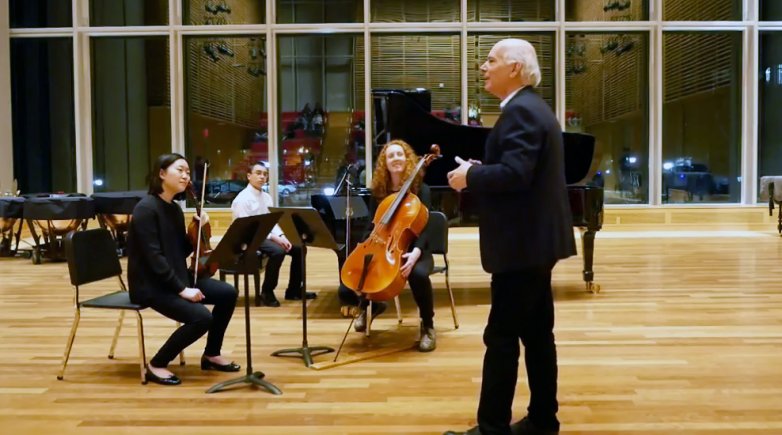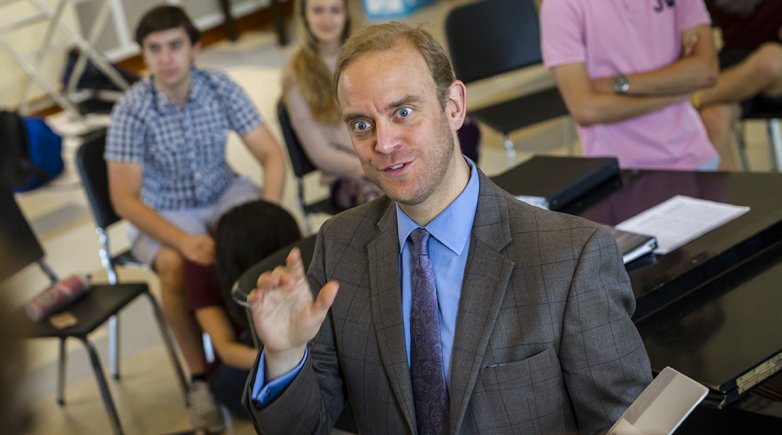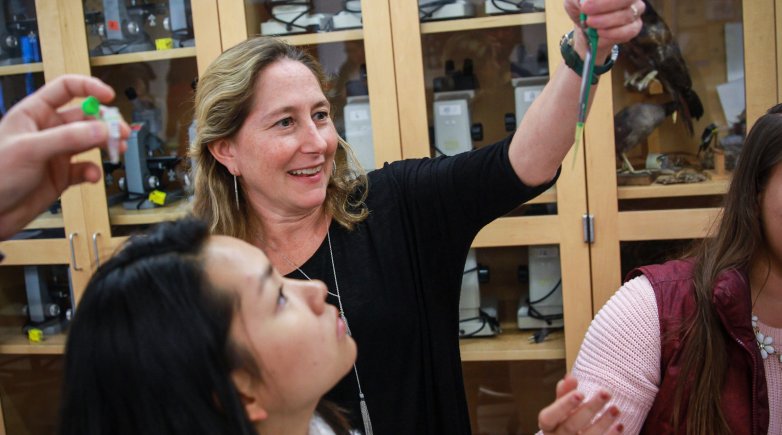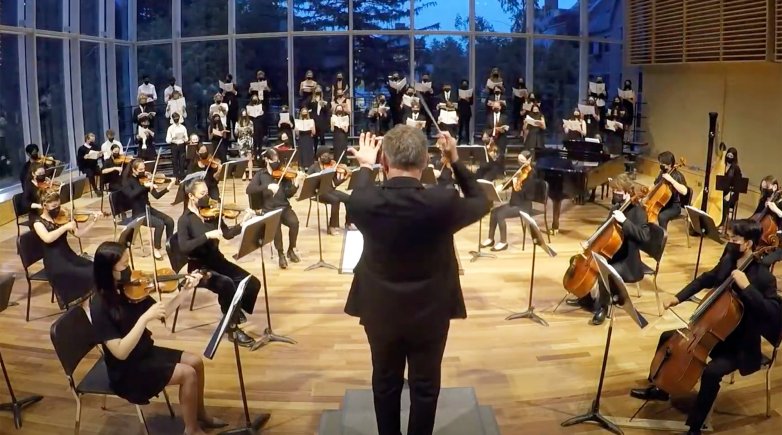Masters of music
Internationally acclaimed Fine Arts Quartet shares chamber music expertise during master class in The Bowld.
At 6:50 p.m. on a wintry Monday evening, students start trickling in to The Bowld.
The auditorium is brightly lit and its exterior glass wall plays tricks. A student seated half way up the raked, red seating looks up from the homework in her lap and sees her reflection in the glass, superimposed over the scene outside: the Lamont Quad, spotted with light from lamps along the paths.
By 6:57, students arrive in chatty clumps. They enter and glance hard over their left shoulders at the seats, scanning for friends. By 7:02, two minutes after tonight’s master class was to begin, it’s a torrent of sneakers, sweatpants, blue jeans and puffer coats.
The audience of more than 100 students and a handful of adults settles down as Kenneth Lee, cello instructor and director of the Exeter Symphonia, moves to the stage and raises his right arm for quiet. He introduces the evening: The Fine Arts Quartet, on campus to perform a program of Mozart, Beethoven and Tchaikovsky in The Bowld the following evening, are here tonight to critique three piano trios prepared by Exeter students.
Loud applause greets Erin Choi ’21 (violin), Mia Glinn ’20 (cello) and Alexander Larrow ’22 (piano) as they walk on stage. After a few moments of adjusting chairs and instruments, Choi nods her head and the students launch resolutely into Beethoven’s Trio in C Minor Op.1 #3. The audience listens intently.
As the music ends, the ensemble stands. Glinn flicks her mane of thick red hair off her left shoulder. Choi looks at Glinn, smiles, and nervously shakes her head. All three bow to applause.
“Beautiful playing,” says ponytailed Niklas Schmidt, Fine Arts Quartet cellist, as he walks to the stage. His mien is the first indication of what will play out for the rest of the evening: kind, firm, clarifying advice. And hugely expert: this quartet has performed to great acclaim for decades, and quartet members teach at conservatories in Paris, London, New York and Beijing.
Schmidt remarks on the feeling of the playing and focuses on the composer’s notation, con brio allegro. “Your attitude at the beginning is more andante. Could you start again? And try to feel everything, like the sixteenth notes and the eighth notes.”
Next up is violinist Efim Boico, a 35-year veteran of the Fine Arts Quartet, who reinforces the message. “With this piece, I like to hear fire. … I want to see the freedom.”
Violinist Ralph Evans, another decadeslong member of the quartet, rounds out with humor: Feel the mood. Express the music with your entire body. Think about conductors: They use expressions to elicit a mood. To illustrate, he conducts the first few bars of Beethoven’s Fifth — first with smooth, placid movements, next with exaggeratedly aggressive ones. The Exonian musicians relax, laughing at the pseudo-slapstick, and comply.
The next student ensemble, dressed in black, hits a formal note as pianist Zhaoran Chen ’20 presents the quartet with a copy of the piece they are to perform, Dvořák’s Trio in E Minor Op. 90.
Formality quickly disappears, however, as their music moves swiftly from staccato lightheartedness to lament. The players’ bodies move rhythmically. The violin enters pianissimo. The cello beseeches. The piano joins in with verve.
This trio is all about the mood.
As the piece comes to an end, violinist Brian Son ’22 and cellist Sophia Chang ’20 hold their bows raised in the air. The audience encircles them with cheers and applause.
Critique pivots to technique for this group as Evans describes how changing the bow pressure can tame the audible shifting between notes. Chang tries it. The audience holds its collective breath. The quartet members lean forward in their seats. “That was cleaner,” says Evans appreciatively.
“You have an electric vibrato,” Evans says to Son with admiration. He advises the young violinist to be more consistent with his vibrato, and save non-vibrato for the occasional “cold, eerier mood.”
The last ensemble — Kiesse Nanor ’22 (piano), Sava Thurber ’22 (violin) and Bona Yoo ’22 (cello) — enters from stage left wearing jeans (black for the cellist, blue for the violinist), brightly colored shirts (red, blue), and lace-up sneakers and boots. They tune the strings carefully. Two minutes in to Beethoven’s Trio in D Major Op. 70 #1, the piano notes soar powerfully to The Bowld’s high ceiling. The cellist leans back in her chair, looking toward the violinist who rocks forward and back, their bodies responding to rhythms.
“You play with fantastic energy and passion” says Evans stepping to the stage. Work on the softer sections and contrast, he advises. “Music is better with variety. Life is better with variety!”
As students start to depart the auditorium for dorm check-in, the older musician feels no rush to bring his critique to an end. “Relax and let it sing by itself,” he says.
Editor’s note: The Fine Arts Quartet residency, along with a concurrent residency by pianist Alon Goldstein, were made possible by the Ilchenko family and an anonymous donor.



